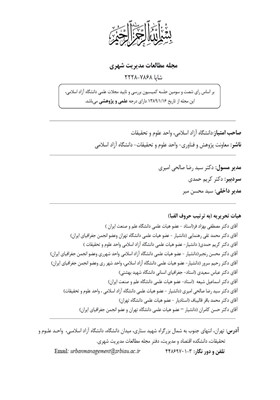تحلیلی بر میزان تحقق پذیری کاربری اراضی شهری در طرحهای جامع شهرهای کوچک (مورد مطالعه شهر عسگران)
محورهای موضوعی : مطالعات مدیریت شهری
مهدی ابراهیمی بوزانی
1
*
![]() ,
رضا محتاری ملک آبادی
2
,
رضا محتاری ملک آبادی
2
![]() ,
ناصر کریمی میرآبادی
3
,
ناصر کریمی میرآبادی
3
1 - استادیار جغرافیا و برنامه ریزی شهری، دانشگاه پیام نور، تهران، ایران. mahdebrahimi@pnu.ac.ir (نویسنده مسئول)
2 - دانشیار جغرافیا طبیعی، دانشگاه پیام نور، تهران، ایران. mokhtaryus@yahoo.com
3 - دانشجوی کارشناسی ارشد جغرافیا و برنامهریزی شهری، دانشگاه پیام نور، تیران، ایران.
naser_216@yahoo.com
کلید واژه: تحقق پذیری, کاربری اراضی, طرح جامع, شهر کوچک, شهر عسگران,
چکیده مقاله :
مقدمه و هدف پژوهش: مهم ترین مسئله در روند تهیه و اجرای طرح های توسعه شهری موضوع تحقق پذیری آنها است و چنانچه این طرحها به نحوی که مقرر شده تحقق یابند، منافع و امکانات عمومی تأمین و بسیاری از مشکلات شهری برطرف می شود؛ به این جهت در این مقاله طرح جامع شهر عسکران از توابع استان اصفهان با سطح شهرهای کوچک مقیاس مورد بررسی قرار گرفته است.روش پژوهش: پژوهش حاضر به لحاظ هدف از نوع کاربردی و به لحاظ ماهیت از نوع توصیفی- تحلیلی است و دادههای آن مبتنی بر منابع اسنادی و مشاهده میدانی است.یافته ها: نتایج پژوهش نشان میدهد که متوسط درصد تحقق پذیری جمعیت پیشنهادی طرح جامع شهر عسگران، برابر با 84/60 درصد است که این رقم میتواند به عنوان متوسط تحقق پذیری کاربریها نیز انتخاب شود. بر این اساس تحققپذیری کاربری های اداری و انتظامی، مسکونی، آموزشی، میراث تاریخی و تأسیسات شهری از حد متوسط بالاتر، و تحقق پذیری سایر کاربریها پایین تر از حد متوسط بوده است. در بین این کاربری ها، دو کاربری تجاری-خدماتی و پارک و فضای سبز تحقق پذیری کمتر از ده درصد داشتهاند و کاربری تفریحی-گردشگری، فضای سبز حفاظتی و درمانی تحقق پذیری صفر درصد و حتی منفی داشتهاند. بدین ترتیب میتوان گفت که تحقق پذیری کاربری اراضی پیشنهادی طرح جامع عسگران بسیار پایین بوده است.نتیجه گیری: طرح جامع شهر عسگران به مانند همه طرح های جامعی که با الگوی سنتی تهیه میشوند از تحققپذیری اندکی برخوردار بوده و با اکثر ضعف ها و تنگناهای این الگو شامل جدایی روند تهیه طرح از مرحله اجرا، قطعینگری در برنامه ریزی و مکانیابی کاربری ها و به دنبال آن انعطاف پذیری اندک و عدم تطبیق با شرایط متغیر مکانی_زمانی، بی توجهی به امکانات مالی و اجرایی شهرداری، کلیشه ای بودن تهیه طرح، بی توجهی به منافع و نیاز ذینفعان، عدم توجه به عوامل کلان اقتصادی و سیاسی و اجتماعی، بی توجهی به مالکیت زمین و ... مواجه است.
Introduction and purpose of the research :The most important issue in the process of preparing and implementing urban development plans is the issue of their feasibility, and if these plans are implemented in the prescribed manner, public benefits and facilities will be provided and many urban problems will be resolved.. However, there are very few studies that show the feasibility of these projects in small towns.For this reason, in this article, the master plan of Askran city of Isfahan province with the level of small-scale cities has been studied.Research method: The present research is applied in terms of purpose and descriptive-analytical in nature and its data is based on documentary sources and field observation.Findings:The results show that the average percentage of feasibility of the proposed population of the comprehensive plan of Asgaran city is equal to 60.84%, which can be selected as the average feasibility of land uses. Accordingly, the feasibility of administrative and disciplinary uses, residential, educational, historical heritage and urban facilities above average, and the feasibility of other land uses have been below average.Among these uses, two commercial-service uses and park and green space had less than ten percent feasibility and recreational-tourism use, protective and therapeutic green space had zero and even negative feasibility. Thus, it can be said that the feasibility of land use proposed by the Asgaran Master Plan has been very low.Conclusions: Asgaran city master plan, like all comprehensive plans prepared with a traditional model, has little feasibility and with most of the weaknesses and bottlenecks of this model, including the separation of the design process from the implementation stage, definite planning and user location Followed by little flexibility and non-adaptation to changing spatio-temporal conditions, disregard for the financial and administrative resources of the municipality, stereotyping of the plan, disregard for the interests and needs of stakeholders, disregard for macroeconomic and political factors And social, ignorance of land ownership, and so on.
_||_

